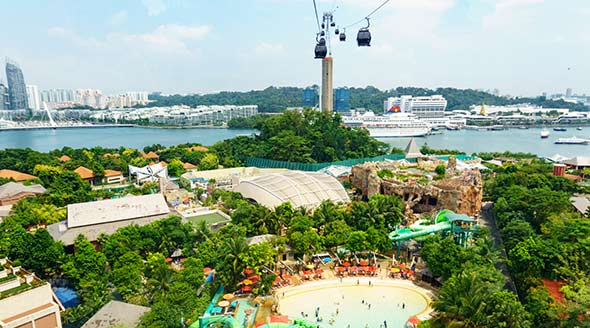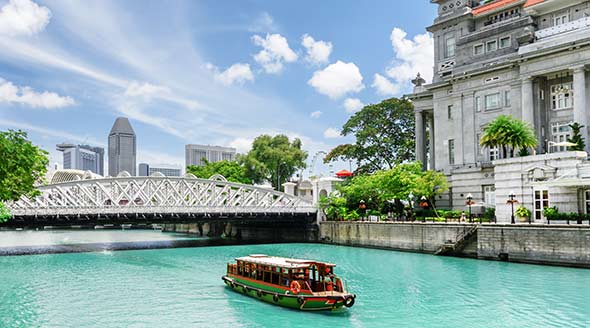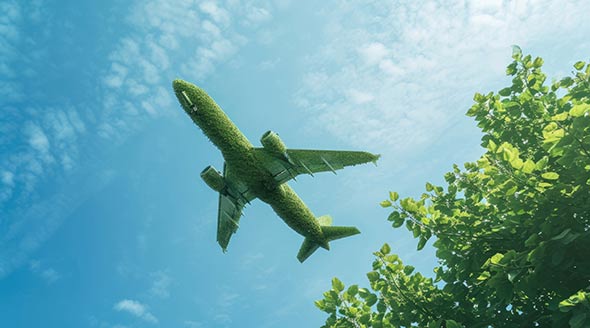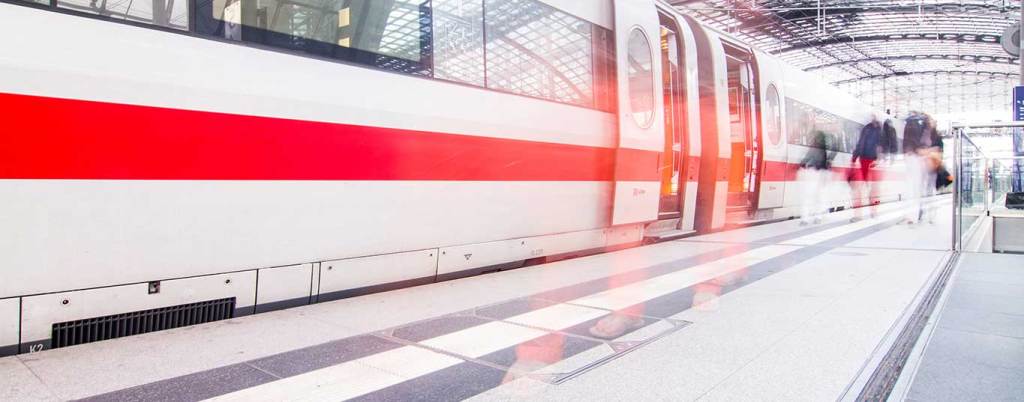Introducing the latest myCWT product and service enhancements
Building on our digital, omnichannel myCWT platform, our new products and services will simplify travel management for you and your employees – anytime, anywhere, anyhow.
Note: Featured services may not be available in your country at this time. Please reach out to your CWT representative for more details.
Hear from Chief Product Officer, Erica Antony as she shares the key product highlights of 2024, along with the key areas driving innovation.
-

2040: Baseline, Boom or Bust
As we enter an era of rapid transformation and unprecedented challenges, it is essential for travel managers, meeting & event planners, and corporate decision-makers to look ahead and frame our current strategic thinking with a clear vision of the future. Business travel and meetings and events (M&E) are poised for significant change over the next decade and a half, driven by a complex interplay of sustainability goals, technological advancements, evolving work models, and geopolitical dynamics.
In this paper to mark the 10th anniversary of our Global Business Travel Forecast, we explore, for the first time, a long-term vision of the future and potential trajectories through three distinct scenarios, each offering insights into how these forces should affect policy-making, budgeting and priorities. By examining these scenarios, we can better understand the diverse possibilities that lie ahead and the strategic imperatives required to thrive in each potential future.
Based on trajectory data analysis and interviews with industry leaders, behaviorists and climate tech founders, this forward-looking approach enables us to anticipate changes, strengthen our strategies, and make informed decisions that align long-term objectives. It is through this lens of foresight and adaptability that we can build resilience, seize opportunities, and navigate the complexities of the future.
We invite you to reflect on the insights presented, and consider how your organization can prepare for the opportunities and challenges that lie ahead. Together we can ensure that travel and meetings remain catalysts for growth, scalability and sustainable practices.
- Scenario development is both an art and a science
- Megatrends Shaping the Future of Business Travel, Meetings and Events
- Sustainability goals the new crux of corporate policy
- Technology Revolutionizes Travel Management
- Modern work models spark new travel patterns
- Changing demographics open doors to new opportunities
- Three Scenarios: Base case, boom and bust
- Future-proofing strategies

-

CWT GBTA Global business travel forecast 2025
When it comes to pricing, global business travel has finally reached an enduring, higher baseline. Prices will continue to rise in 2025, but only moderately, so expect a period of normalized growth.
However, this pricing environment, one of marginal gains and price regularity, is fragile. Global leisure travel has now realized a lot of its pent-up demand, while corporate travel has been resurgent, with 2024 edging at preCovid levels.
There are many factors at play, whether its volatile oil prices, labor costs and constraints, inflationary pressures, and geopolitical factors. As this elevated baseline edges upwards, albeit marginally, travel budgets will come under increased scrutiny, especially as travel patterns and attitudes change.
It’s why business travel can’t be viewed in a silo, and the true value to an organization must be fully realized. This forecast can help with those calculations.

-

Capitalize on emerging technologies in corporate travel
Technological advancements are accelerating at an unprecedented pace. How will emerging innovations like Generative AI, blockchain, and self-sovereign identity (SSI) transform corporate travel?
BTN and CWT probed global CEOs, travel managers, industry consultants and tech experts on the promises, questions, and expectations these innovations raise and how they are set to reshape traveler experience, cost control and service delivery in corporate travel and events.
Download and discover
- The technologies that will have the greatest impact on corporate travel in the next 2-5 years
- How these emerging technologies are poised to control costs, enhance service and security, and boost efficiency
- The critical challenges, opportunities, risks and roadblocks each innovation raises
- What travel managers, buyers and experts anticipate from these innovations

-

An M&E expert’s vision on innovation and agility in travel and meetings for Life Sciences/Pharma
Regulatory changes in the pharmaceutical industry call for agile and innovative meetings and events. Working closely with our customers in pharma, biotechnology, medical devices, healthcare services and humanitarian organizations, we strive to keep up with the key trends shaping their meetings management.
Jessica Weller, Senior Director Life Sciences/Pharma, Global Strategic Customers at CWT Meetings & Events, spent two decades in travel and meetings, most recently pioneering a combined travel and meetings program for a major pharmaceutical client across 34 countries. Weller manages multiple strategic global programs helping to maintain a 98% client retention rate and 42% growth rate for M&E life sciences clients. Weller is on the Pharma Forum advisory board EMEA and US, sharing best practices and developing future trends.
We ask her to describe the changes underway and the specific needs of Life Sciences companies.
What are the leading trends in pharma meetings management?
- Flexible meetings & events
The race for personalized medicine and targeted therapies demand faster approval processes, balanced with industry-specific regulations and patient safety. Travel and meetings providers must adapt swiftly to shorter lead times and evolving scope. Flexibility is key, and scalable staffing models are critical for success.
In 2023/2024, our clients faced staffing challenges during peaks and troughs. Enter our solution: an hourly subscription model. This flexible staffing approach allowed clients to adapt swiftly, ensuring optimal resource allocation to get the service they need, when they need it, at the best cost. - AI- optimization
Data is the lifeblood of informed decision-making. The better the data, the sharper the insights. AI-driven analytics empower us to optimize and streamline management processes. In a world where most of our customers undergo internal restructuring, we must harness data to drive efficiency. Notably, 60% of our clients now juggle dual roles—travel and meetings—requiring seamless integration.
How will the meeting planning experience for Life Sciences customers evolve by 2025?
We are going to see a huge shift whereby artificial intelligence will handle most of the basic tasks for us, such as venue sourcing with oversight and control by our meetings experts to ensure accuracy and suitability. I think that in the life sciences space we will see an expectation of 100% Transfers of Value (TOV) and regulatory reporting and accuracy as it will likely be automated. A single experience, team and process will lead to the same customer experience across all lines of business.
Are sustainable events still on companies’ radars?
90% of our global client-base are interested in making their meetings and events more sustainable. We recently developed a strategy for a medical device company to plan a memorable and fully sustainable event for 120 attendees in Verona, Italy. Sustainable practices – from venue selection at walking distance from the train station to excess food donation and biodegradable packaging, were integrated into all stages of planning and throughout the supply chain. Carbon emissions were tracked through our partnership with Thrust Carbon and an industry sustainability standard (ISO 20121) was achieved for design, organization and realization of a sustainable event.
What final thoughts would you like to share about the future of meeting management in life sciences?
By leveraging artificial intelligence, fostering regulatory compliance, and embracing flexible staffing models, life sciences firms can create meaningful advancements and set new standards for excellence.
Discover how CWT can help with Life Sciences and Pharma travel.
- Flexible meetings & events
-

Overhyped or underrated? CWT tech leaders on Gen-AI in business travel
“Large language models are like a detective story,” said Matthew Newton, CWT’s VP and Chief Architect on a Business Travel Show panel in June 2024, “Gen AI allows you to predict the whodunnit.”
Indeed, it’s Gen AI’s ability to predict an outcome with accuracy that appeals to the masses at the moment. The future impact of AI is a leading topic of conversation on tech panels and at dinner tables the world over. Given the eye-popping speed, hype and investment that has gone into developing AI, some believe we’ve already become disillusioned. Market research firm Gartner said in its 2023 AI Hype Cycle paper that generative AI was at the “peak of inflated expectations” and fast reaching the “trough of disillusionment.”
Karen Hutchings, founder of Cobb and Hutch Consulting tells in BTN & CWT’s 2024 white paper, Emerging Technologies in Corporate Travel, “Technology is coming like a freight train. Traditional companies are not waking up fast enough.”
CWT’s enterprise architecture team develop digital strategies, manage enterprise technology environments, and deliver customer-centric digital solutions for clients in 139 countries, to modernize core systems and enhance differentiation.
Seeing as a good prediction relies on the quality of underlying information, we ask the team for their view on the hype and reality of Gen AI in business travel:
There will be waves
“Gen AI won’t develop along a single curve. We’re seeing wave after wave after wave as new parties and new entrants enter the conversation. A trough of disillusionment is inevitable. When smartphones first arrived on the scene, it was the battle between that and the Blackberry. It was a similar story with the internet before that. The interesting difference this time around is the speed at which Open AI has become successful and the conversations that people are having are at every level and every function across the business. This isn’t something that’s just being spoken about in ‘technology.’ Gen AI brings together two facets of an enterprise, the business community and the technology community. That’s always going to be a good thing.”
– Matthew Newton VP and Chief Architect
Speed to market keeps Gen-AI relevant
“Sometimes people get excited about a hype and then disappointed when it doesn’t play out either to their expectations or timescale. With AI we’ve seen real results in very short timescales and we can get an AI product to the market place far quicker than most technologies. We’re able to deliver interesting results for our customers, fast.”
– Gordon Coale Senior Director, Enterprise Architecture .
Tried and tested wins the race
“Open API is accessible almost to everyone, which is very different from previous machine learning algorithms, large language models, or even transformers. Like many experiments, out of 100 ideas, maybe 10% will be successful. Like in many organizations, our product team experiments before converging around one or two ideas. The hype phase stabilizes but this phase is where the value lies.”
– Xiaolan Sha Senior Director, Data Science & Machine Learning
Data with destiny
“When you have a large volume of data, you can use large language models to answer the right questions. You can use it to make agents more productive across varied clients and client policies. But large language models need to be trained correctly. They are probabilistic models trained by asking them to complete a piece of text. They will always try to respond. They don’t tend to say ‘I don’t know the answer.’ Users of AI need to apply safeguards, employ domain engineering and a robust validation framework to avoid hallucination. Models need to be scored and fine-tuned but the impact on productivity is enormous.”
– Leonidas Constantinou, Senior machine learning engineer
Whether related to cost-savings, personalization, or security, the potential for Gen-AI to boost productivity and combine disparate data to deliver insights at speed, its potential is vast. To find out more about the opportunities, risks and challenges of Gen AI and other applications, read Emerging Technologies in Corporate Travel.
Image credits: Adobe Stock
-

Event planning in Paris 2024 – Olympic-sized challenges
Organizing an event is always a challenging task, but it becomes even more demanding when it coincides with a significant event like the 2024 Olympics in Paris. The influx of visitors, heightened security measures, and increased demand for resources require event planners to be exceptionally strategic, however, CWT Meetings & Events’ Bertrand D’Argoeuves suggests that maybe avoid hosting business events in Paris for the duration, unless, of course, they’re related to the big event itself.
The Olympics are probably the biggest sport and cultural event that countries have the honor of hosting. The host city is voted by the Olympic Committee against several other countries. Many different criteria are taken into consideration (including participation rate as host in the Games’ history, size of the country, existence of sport facilities, quality of transportation network, and capacity to develop some specific architectural building in a short time). The hosting country has the time to prepare, build, create, renovate, and get ready to welcome thousands of tourists coming to enjoy the show for a two-month duration.
Host cities are chosen at least 8 to 10 years prior to the event. Most of the well-developed countries, well equipped in terms of sport venues, dream to host the Olympic Games at home. It is such an economic boost for the host across many sectors including F&B, accommodation, tourism, retail, and sports events of course, as well as leaves a legacy for sports stars of the future!
Is there any space for something else during this period?
As one of the biggest events, the entire country is mobilized. In terms of security, the public transport and the road network are being adapted or modified to commute more efficiently. Hotels have been working hard to get ready for this once in a century event. Numerous technology investments are made to navigate various services and demonstrate that the host is ahead of the game.
Everyone seems to come to a standstill a few weeks before the opening ceremony. This year’s Olympics marks a century since they were last held in Paris. Given how rare it is to host the Olympic Games, I doubt Parisians will recognize their city in terms of its atmosphere.
So how do you plan and hold meetings and events in a European capital during the Olympics?
In short – you don’t (unless it’s associated with the event itself).
Hotel bookings were made months in advance, with massive inflation on the prices: 50% up on the Parisian market but with an occupancy of 25% lower than last year at the same time so far. Hoteliers expect and hope for some last minutes bookings as the Games get closer.
For the rest of the country, it is similar, prices have risen up to 32% in major cities like Marseille, Lyon, Nice and Bordeaux with 9% occupancy level compared to last year. The south of France however doesn’t need the Olympics to have a full occupancy rate. The French riviera is always a tourist hot spot in the summertime.
It is interesting to see that there aren’t any B2B bookings for meeting space, and there is hardly any corporate event: firstly, because the prices of accommodation are very expensive. Secondly, it has been communicated for months that getting around in Paris during the games will be complicated. The entire city will breathe the Olympics and will be configured for the Olympics. This does not really motivate companies to organize meetings during this time.
On a wider scale, all the major summer sport and cultural events in France are cancelled, except for the “Tour de France”. Major summer music festivals are also cancelled, for security reasons. Most of the security manpower will be mobilized for the Olympic Games and won’t be available for other big events.
Organizing an event during the Olympic Games is quite ambitious, but with flexibility, a simple brief, a lot of anticipation and with a sharp expertise of the Parisian market, it is possible – but expensive – to make it a success!
Image credits: Adobe Stock
-

CWT rolls out upgraded air price optimization solution, generating bigger savings for travel programs
CWT is rolling out an upgraded version of its airfare optimization service, which is powered by Wenrix, a leading travel technology company providing AI and advanced analytics solutions. The new platform uses enhanced AI and machine learning models and extends the window during which prices can be optimized, helping customers secure even lower airfares.
Integrated into all of CWT’s booking channels, the solution effectively predicts changes in air ticket prices. It then automatically rebooks existing flight reservations if it identifies an opportunity to achieve savings, factoring in any change and cancellation fees and ensuring compliance with airlines’ fare rules and regulations. CWT’s dedicated price optimization team also makes sure that every savings alert yields net savings without compromising the traveler experience.
“Our price optimization service is one of the simplest ways for our customers to save on their air spend,” said Erica Antony, CWT’s Chief Product Officer. “It’s a turnkey solution that has minimal set-up and maintenance requirements and doesn’t cause any disruption to travelers. Through our partnership with Wenrix, we have combined the experience and expertise of our people with advanced technology to create a market-leading price optimization solution that delivers even bigger airfare savings and a seamless traveler experience.”
CWT commenced a pilot with select customers in the United States and Europe in 2023. Some of these early adopters have seen their savings increase by as much as double compared to when they were using the previous version. The upgraded solution is now available to all customers in 12 countries and will be rolled out in additional markets in the coming months.
CWT is a leading global partner in business travel, meetings, and events. Operating across six continents, we deliver sustainable, tailored solutions that help organizations connect, engage, and thrive in an evolving world. Our myCWT platform integrates advanced technology with human expertise to simplify travel and enhance traveler and attendee experiences. Extensive global coverage, seamless data integration, AI-driven analytics, and carbon-conscious travel tools enable businesses to optimize their travel and meetings programs while delivering measurable value.
With 150 years of industry experience and a deep commitment to partnership, CWT collaborates with clients to shape the future of business travel and events, making them more efficient, responsible, and impactful.
-

Singapore – The ultimate hub for world-class events and conferences
Singapore is often voted top destination for MICE in the APAC region. Not surprising, as it’s an exceptional choice for meetings and events with its boasting state-of-the-art facilities, remarkable venues, seamless connectivity, and vibrant cultural landscape. This city-state stands out not only for its business-friendly environment but also for its unique blend of modernity and tradition. It’s even host to one of the most thrilling races in the Formula 1 calendar as cars race through the city streets at night. Let’s explore why Singapore should be your next destination for business events and gatherings.

Recommended event venues
Marina Bay Sands is an iconic venue with its unique architecture and world-class facilities. The Sands Expo and Convention Centre offers over 120,000 square meters of flexible space, making it ideal for large conferences, exhibitions, and meetings.
For a touch of colonial elegance, the Raffles Hotel provides a historic setting with modern amenities. This venue is perfect for more intimate gatherings and high-profile events, offering a blend of luxury and heritage. And it’s just a short walk to the Singapore International Convention & Exhibition Centre.For a truly extraordinary venue, consider Gardens by the Bay, featuring in Tripadvisor Travellers’ Choice 2024 list of the top ten attractions in the world. With its futuristic Supertree Grove and the stunning Flower Dome, this location offers unique spaces for events amidst lush greenery and breathtaking views.
Located near the airport, Changi Exhibition Centre is a versatile venue known for hosting large-scale events like the Singapore Airshow, Asia’s largest aerospace and defense event, attracting industry leaders from around the world. Its vast outdoor and indoor spaces make it suitable for exhibitions, conventions, and concerts.
Getting there and getting around
Singapore is a major global hub, known for its excellent connectivity. Changi Airport, consistently rated as one of the best in the world, connects Singapore to over 400 cities in 100 countries. Within the city, the public transport system is efficient and reliable, featuring an extensive network of buses and the Mass Rapid Transit (MRT) system. This ensures easy access to all major venues and attractions, making transportation hassle-free for event attendees.
Activities for groups
For group events, Singapore offers a diverse range of activities that cater to different interests and budgets, from cooking classes and adventure courses to guided tours and entertainment options.
- Sentosa Island
A premier destination for group activities, Sentosa Island offers attractions like Universal Studios Singapore, Adventure Cove Waterpark, and S.E.A. Aquarium. It’s perfect for team-building activities and relaxation. - Singapore River Cruise
Experience the city from a different perspective with a Singapore River Cruise. It’s a great way to see landmarks like Clarke Quay, Boat Quay, and Marina Bay Sands while enjoying a scenic ride. - Cooking classes
Engage your team in a fun and interactive cooking class. Learn to prepare local dishes such as Hainanese chicken rice or laksa. This activity is not only enjoyable but also offers a taste of Singapore’s rich culinary heritage. - Kampong Glam and Chinatown Tours
Discover the cultural heart of Singapore with guided tours of Kampong Glam and Chinatown. Explore vibrant streets, visit historic sites, and sample traditional foods while learning about the city’s diverse heritage.

Sentosa Island 
Kampong Glam 
River cruise What makes Singapore unique?
- Cultural diversity
Singapore’s multicultural society is reflected in its festivals, cuisine, and architecture. This diversity creates a rich cultural tapestry that enhances the overall experience for event attendees. - Clean and green
Known for its cleanliness and green initiatives, Singapore is often referred to as a “City in a Garden.” Its commitment to sustainability is clear in its urban planning and many green spaces. - Innovation hub
Singapore is a global leader in innovation and technology, providing cutting-edge facilities and infrastructure. This makes it an ideal location for tech conferences and events focused on future-forward industries. - Safety and efficiency
Ranked as one of the safest cities in the world, Singapore offers a secure environment for international visitors. Its efficient public services and well-maintained infrastructure ensure a smooth experience for event organizers and participants alike.
Something for every wallet
While Singapore is known for its high standards and exceptional quality, it also offers a range of options to suit different budgets. Luxury venues like Marina Bay Sands and Raffles Hotel are premium options, while mid-range hotels offer more affordable rates. Unique venues like Gardens by the Bay provide distinctive settings. Accommodation costs vary from high-end luxury hotels to more budget-friendly options.
Dining expenses range from fine dining and casual restaurants to economical hawker centers. Public transport is affordable, and taxis or ride-hailing services are slightly more expensive. Event services such as AV equipment, planners, and decorations also span a wide range of prices. Team-building activities and entry fees for popular attractions vary as well. Understanding these cost variations helps ensure efficient planning and a successful event that fits various budgets.
Singapore’s blend of modernity, tradition, and exceptional infrastructure makes it a premier destination for meetings and events. Whether you’re planning a large conference, a corporate retreat, or an intimate gathering, Singapore offers a myriad of options to cater to your needs. Its unique venues, diverse cultural experiences, and seamless connectivity ensure that every event is a memorable success. Choose Singapore for your next event and discover why it truly is the ultimate destination for business and pleasure.
Unique laws and rules in Singapore: What you need to know
Singapore is renowned for its strict laws and efficient enforcement, which contribute to its reputation as one of the safest and most orderly cities in the world. As you plan your event or visit, it’s important to be aware of some unique laws and regulations to ensure a smooth and trouble-free experience. While some are just respectful things to do or not do wherever you go, others are very specific
No littering
Littering in public places is strictly prohibited, and offenders can be fined up to SGD 1,000 for the first offense. Repeat offenders face even higher fines and may be required to perform community service.No spitting
Spitting in public places is also illegal and can result in fines. This law helps maintain the cleanliness and hygiene of the city.No chewing gum
The sale and import of chewing gum are banned in Singapore, except for therapeutic, dental, or nicotine gum, which requires a prescription. This law was introduced to prevent gum litter and maintain the cleanliness of public spaces.Designated smoking areas
Smoking is banned in most indoor and outdoor public places, including restaurants, shopping malls, parks, and bus stops. Smokers must use designated smoking areas to avoid fines, which can be as high as SGD 1,000.No jaywalking
Jaywalking, or crossing the street outside of designated pedestrian crossings, is illegal and can result in fines. Pedestrians must use marked crosswalks and obey traffic signals.No eating and drinking on public transport
Eating and drinking are not allowed on public transportation, including buses and the MRT. Offenders can be fined up to SGD 500.Gong-Gong and Chee-Bye
These terms might seem innocuous but using them can get you in trouble. They are considered offensive and vulgar in Singapore and using them in public can result in a fine or even jail time.Durian on public transport
Durians, known for their strong odor, described as resembling dirty gym socks, rotten egg, cut onions, manure, and roadkill, are not allowed on public transportation. This rule helps ensure a pleasant environment for all commuters.Toilet flushing
It’s mandatory to flush public toilets after use. Failure to do so can result in a fine of up to SGD 150. This law ensures hygiene and cleanliness in public restrooms.
WOWevent – Celebrating a landmark anniversary in New York
Organized meticulously by CWT for one of our customers, this trip was not just a special occasion to celebrate the company’s 50th anniversary, but a gateway to new experiences, camaraderie and discovery.
Months of dedication and effort culminated in this exciting moment… five days in New York, the city that never sleeps. See an impression of the event
Image credits: Adobe Stock
- Sentosa Island
-

Top Tool: What should we expect from modern reporting?
The tool or set of tools used for reporting is the technological backbone of any reporting system, encompassing databases, data warehouses, data lakes, Extract, Transform, Load (ETL) processes, and reporting software, all while accommodating the needs of different users, from data scientists to business executives.
Since the early 90’s, Excel was the undisputed king of analytics. With the rise of “big data” and the emergence of increasingly sophisticated business insights (BI) tools, such as Tableau, PowerBI, Thoughtspot, and a host of new entrants each year, there are now more efficient methods of managing and analyzing data.
There are shortfalls of using raw data and Excel. So, what are the features and functionalities we should expect our modern reporting tools to do?
There are a variety of technical and important features that happen behind the scenes of analytics tools and should primarily be managed by your reporting partner. Examples include data preparation, data modeling, security, user administration, and authentications. Tool performance and accessibility also fall into this bucket of functional features as we would like to assume that your content will load when you need it and in a timely manner.
That said, at a high-level, the ease and availability of the following foundational capabilities are what you should look for in an effective reporting tool:
Find: The first and simplest, but I believe the most important, is that users must be able to find standard content quickly and easily. Having a library full of incredible dashboards is of little use if the user cannot find what they need. It can be as simple as a clear structure of folder hierarchy, something more complex like the use of tags or groupings, or my favorite, which is using synonyms and keywords that allow users to enter a few words into a search box to find all related content.
Customize: Next is a user’s ability to customize content. Let’s say your BI tool’s library of standard content has a report that meets 95% of your needs. If the tool does not allow you to customize that last 5%, the default is then to extract and build (which we’ve already demonstrated should be avoided). The customization may be something simple like preferring a stacked column over a pie chart or maybe adding in a company logo and colors. It could also be more complex like custom grouping and lookups, custom formulas, or what-if scenarios. By allowing customization, users can stay directly connected to the data and maintain the benefits of working within the tool.
Automate: The purpose of technology is to help simplify tasks. An analytics tool is no different and should offer automation capabilities. Some people ‘love’ logging into a BI tool and spending hours digging into the insights. Others do not even want to look through a report. For these ‘non-user’ users especially, automation helps to make analytics more enjoyable and digestible. The easiest way to do this is to automatically deliver reports, insights, and recommendations directly to them. Your reporting tool should allow users to set a schedule and forget it, with the desired content summary sent directly to their inbox. Additionally, your tool should be able to set recurring or threshold-based alerts, so you don’t even need to read a report.
The tool should monitor your key performance indicators (KPIs) and alert you if a target has been hit or missed. For example, it should send me an alert when 90% of my monthly carbon budget has been reached. Or, if there is a sudden percentage change in my online adoption. Additionally, the tool should intelligently know which data each recipient has access to. Meaning, if I need to send a report to multiple users with different levels of data access, the tool should be intelligent enough to automatically modify the report, sharing only relevant data to each recipient.
Interact: The ability to interact with content is a must. Our dashboards and reports should tell stories. Much like the “choose your own adventure” books many of us grew up reading (or reading to our kids), there are many different paths we can take while on our reporting journey. Core interactable functionality includes the ability to drill down, show underlying data, implement dynamic filters, and apply brushing and linking (cross filtering) just to name a few of the basics. Essentially, if we see something that interests us, we should be able to easily delve into it for more insights and details.
Collaborate Data extraction often leads to working in silos. Your tool should allow for content to be shared, viewed, managed, and edited by numerous people and simultaneously in real-time. Collaboration in reporting tools enhances communication, decision-making, and overall team effectiveness, leading to better outcomes for organizations. Whether it’s tracking financial data, monitoring progress, or analyzing performance metrics, collaborative reporting tools play a vital role in achieving your program and business goals.
What’s next?
A successful analytics framework should help you discover, interpret, and communicate opportunities and challenges for your program, employees, and business. This begins with ensuring you have access to Data that is complete, relevant, accurate, and timely. But data on its own holds little value, especially if it’s unorganized. The power of data lies in structuring it into meaningful Content to illuminate patterns, anomalies, and trends—often revealing answers to previously unrecognized problems. Creating this content should never require you to start from scratch and should always be customizable. We may all be looking for similar answers, but we may not all process information the same way. This is where having a flexible tool is a must. Tools are the basis for facilitating various user interactions from finding to customizing content, automating tasks for efficiency, and enabling collaboration.
Once you have established the effectiveness of your data, content, and tool, you can enhance your analytics framework through more sophisticated features such as AI-powered insights and predictive modeling—many of which CWT is already exploring and testing in our own BI platform today.
See also the 2 other blog posts in this series about travel reporting:
A step-by-step guide to turning content into actionable insights
Fine Figures: How to get the most value out of your travel dataImage credits: Adobe Stock
-

Discover Atlanta – Southern charm in the City of Trees
When it comes to choosing a vibrant, versatile, and well-connected location for meetings and events, Atlanta, Georgia, stands out as a top contender. Known for its rich history, diverse culture, and southern charm, Atlanta offers a unique blend of modern amenities and traditional hospitality. The city is situated in the Deep South of the southeastern United States among the foothills of the Appalachian Mountains, at an elevation of just over 1,000 feet (300 m) above sea level. It features unique topography that includes rolling hills, lush greenery, and the densest urban tree coverage of any major city in the United States.
Recommended venues
- Georgia World Congress Center
One of the largest convention centers in the United States, the Georgia World Congress Center (GWCC) offers over 1.4 million square feet of flexible space. With its state-of-the-art facilities and central location, GWCC is ideal for large conferences, trade shows, and exhibitions. - The Fox Theatre
For a touch of grandeur and history, The Fox Theatre is a must. This 1920s movie palace now serves as a premier venue for concerts, Broadway shows, and private events. Its stunning architecture and luxurious interiors provide a memorable backdrop for any occasion. - Porsche Experience Center
For a unique and extraordinary venue, the Porsche Experience Center offers an upscale, adrenaline-fueled experience. Groups can enjoy meeting spaces with views of the track, team-building activities, and even test drives on their renowned track. - Atlanta History Center
Set on 33 acres in the heart of Buckhead, the Atlanta History Center combines historical exhibits with beautiful gardens and event spaces. It’s perfect for groups looking to incorporate a bit of culture and history into their event. - The Stave Room
Located at American Spirit Works Distillery, The Stave Room offers a unique, rustic-chic space for corporate events, galas, and social gatherings. With its soaring ceilings, exposed brick, and polished concrete floors, it provides an industrial yet elegant atmosphere.
Recommended sites and fun facts
- The BeltLine
Atlanta’s BeltLine is a massive urban redevelopment project that, once completed, will connect 45 neighborhoods via a 22-mile loop of multi-use trails, parks, and transit options. It’s perfect for group walks, bike rides, or segway tours. - World of Coca-Cola
Discover the history of one of the world’s most famous beverages. This interactive museum offers a fun and informative experience for groups of all sizes, complete with tastings of Coca-Cola products from around the world. - The Varsity
An Atlanta institution since 1928, The Varsity is the world’s largest drive-in restaurant. It’s a quirky, fun spot for a casual group outing where everyone can enjoy classic American fast food. - Fun Fact: The Phoenix City
Atlanta is known as the “City of trees” or “City in a Forest” due to its abundance of trees, and also as the “Phoenix City,” symbolizing its rebirth after being nearly destroyed in the Civil War. This spirit of resilience and renewal is woven into the city’s fabric.

Swan house in the Botanical Gardens 
BeltLine 
Botanical Gardens Connectivity and transport
Atlanta is a major transportation hub, making it incredibly accessible for attendees from around the world. Hartsfield-Jackson Atlanta International Airport is one of the busiest airports globally, offering direct flights to over 150 U.S. destinations and more than 70 international cities. Within the city, MARTA (Metropolitan Atlanta Rapid Transit Authority) provides convenient public transportation options, including buses and rail services, ensuring seamless connectivity across the metropolitan area.
Recommended activities for groups
- Escape rooms
Atlanta boasts several top-rated escape rooms, perfect for team-building exercises. Options include The Escape Game Atlanta and Paranoia Quest, where groups can work together to solve puzzles and escape themed rooms. - Atlanta Botanical Garden
A lush oasis in the city, the Atlanta Botanical Garden offers guided tours, seasonal exhibits, and beautiful spaces for group activities and events. It’s an excellent venue for an afternoon of relaxation and exploration. - High Museum of Art
For a dose of culture, the High Museum of Art features an extensive collection of classic and contemporary art. Group tours and private event spaces make it a sophisticated choice for corporate outings. - National Center for Civil and Human Rights
This museum is dedicated to the achievements of the civil rights movement in the United States and the broader worldwide human rights movement. The center hosts a number of exhibitions, both permanent and temporary, that not only tell the history of the civil rights movement in the United States, but also how that period is related to more contemporary human rights struggles around the world. - Atlanta Braves Game
Catch a baseball game at Truist Park, home of the Atlanta Braves. Group tickets and suites are available, providing an exciting and social environment for colleagues and friends to bond over America’s favorite pastime.
Major events in Atlanta
Atlanta has hosted a variety of high-profile events, including the GBTA Convention, and the Dragon Con, an annual pop culture convention, attracting visitors from far and wide. But also these less recent ones:
- NCAA Men’s Final Four in 2020, though it was unfortunately canceled due to the pandemic, highlighted Atlanta’s capacity for large-scale sports events.
- Super Bowl LIII in 2019, which brought thousands of visitors and showcased the city’s hospitality and event-hosting capabilities.
- 1996 Summer Olympics, the fourth Summer Olympics to be hosted by the United States, marking the 100th anniversary of the 1896 Summer Olympics in Athens, the inaugural edition of the modern Olympic Games.
What makes Atlanta unique
Atlanta’s unique charm lies in its blend of historical significance and modern vibrancy. The city’s role in the Civil Rights Movement, marked by sites like the Martin Luther King Jr. National Historical Park, adds a profound depth to any visit. Additionally, Atlanta’s flourishing culinary scene, eclectic neighborhoods, and commitment to arts and innovation make it a dynamic destination for events of all kinds.
Image credits: Adobe Stock
- Georgia World Congress Center
-

A step-by-step guide to turning content into actionable insights
In the immortal words of lead singer Ed Robertson, “It’s all been done.” This certainly applies to reporting content, whether it is a simple table or an interactive dashboard. Consumers of data, generally, should never have to work from scratch. You should be provided with a library of content that fills most of your reporting needs. In most cases, if you want to report on something, someone else has already done it. So, why not leverage existing content and reduce your workload?
If your current reporting partner is not providing you with standard content that fulfills the majority of your needs, you have a reporting gap. For example, CWT customers have access to 45+ dashboards within our growing reporting library, focused on key topics like:
- Program Summary
- Program Detail
- Sustainability
- Booking Behavior
- Real-Time Analysis
- Price Optimization (reprice)
- Unused Ticket Tracking
- Hotel Rate Suppression and Availability
- Safety & Security
- Data Assessment
- Supplier
Your reporting partner should be an expert on not only the nuances of how to use raw travel data, but also the best way to use that data to tell a relevant, clear, and actionable story. It should tell a story that uncovers trends, patterns, and anomalies that may require attention or action.
My favorite example of this is reporting on Average Ticket Price (ATP) vs. Advanced Purchase Days. The common belief is that flights are generally cheaper the further out they are booked. But that’s not the case if we look at it from a 10K foot view. Instead, we see average ticket prices increasing the further out we book. The simple answer is that there is a direct correlation between the cost of a flight, its traveled distance, and its advance days booked. Essentially, if I need to travel internationally from Minneapolis to Singapore vs. a short trip from Minneapolis to Chicago, I’m more likely to book my flight a month in advance. We can see this relationship shown in the below chart. For extra credit we see an undulation of average traveled miles by advanced booking days, which tells us another interesting story about how booking volumes and behaviors are impacted by the day of the week.

(Click the image for a larger version) All this to say that creating compelling and useful content requires a deep understanding of the business context and the objectives of the user. Content creators must be adept at selecting the right metrics and key performance indicators (KPIs) to track, employing appropriate methods, and choosing the best visualization techniques to convey the message effectively.
While CWT’s expansive base content meets the needs of most users, it also serves as a solid foundation for those looking to build more sophisticated reports. The capabilities of the tool that houses the content, should enable that next level of customization—which I’ll delve into on the next blog, so stay tuned!
See also the 2 other blog posts in this series about travel reporting:
Top Tool: What should we expect from modern reporting?
Fine Figures: How to get the most value out of your travel dataImage credits: Adobe Stock
-

Fair Play: How to spot and prevent Gen AI bias in business travel
Generative AI, Self-Sovereign Identity (SSI), and Blockchain will have the biggest impact on global business travel posits a new white paper by CWT and BTN, Emerging Technologies in Corporate Travel. The report gleans from tech experts, global CEOs, travel managers and industry consultants the leading innovations set to change traveler experience, cost control and service delivery for corporate buyers and travelers while outlining the benefits, opportunities, and risks that each application presents.
Gen AI is hailed by some as a panacea for efficiency, transparency, and personalized service. Tools like Google Genesis and Chat GPT are transforming travel management by integrating disparate data strands like traveler preferences, corporate guidelines, and trip details to deliver personalized experiences like never before.
Developments in automation and data amalgamation could even lead to the Gen AI agent of the future who will be able to turn a wish list into a bookable itinerary optimizing for price, loyalty, cancellation policies, perks and conditions.
Like the internet in the 1990s, now is a defining moment for tech and a chance to reinvent how we do things in all areas of life. But as with any flashy new build, foundations matter.
“Algorithmic bias in AI-powered decision-making poses a significant threat to various aspects of our working and traveling lives,” says Matthew Newton, CWT’s VP IT architecture who is responsible for developing customer-centric digital strategies for clients in 139 countries, “tackling bias has become as important to me as modernizing core systems and enhancing differentiation. The consequences of ignoring the potential for bias are vast, creating disparities in budget allocation and reducing employee well-being, resulting in some employees feeling marginalized.”
We ask Newton to explain algorithmic bias in the context of corporate travel and how organizations can work to prevent it:
Playing favorites: How does algorithmic bias present in business travel?
To tackle algorithmic bias effectively, it’s vital to first recognize the different types and then understand underlying causes.
Implicit bias leads to preferential treatment or discrimination in recommendations based on gender, ethnicity, and age. Statistical bias favors or disadvantages demographics based on historical data patterns, resulting in unequal access to travel choices. Training data bias reflects existing biases in past records which could limit options for individuals from certain regions.
These biases mirror societal discrimination, such as speech recognition systems being more accurate for male voices than female voices, with even more disparities across ethnicities.
I recently explored the complexities of algorithmic bias with the teams responsible for CWT’s Intelligent Display which uses machine learning to recommend relevant and policy-compliant hotels to travelers. We started with balanced, contextually relevant training data to minimize bias by curating diverse datasets and excluding sensitive attributes like age, gender, ethnicity, and socioeconomic status.
An algorithm like the one that powers Intelligent Display may favor hotels in certain high-end neighborhoods, assuming they are safer or more comfortable or flights with tight layovers for efficiency. However, if the algorithm fails to consider the requirements of employees with additional needs or those traveling with families, travelers might incur higher out-of-pocket expenses, feel stressed and miss connections, leading to out-of-program travel bookings. The program’s success hinges on fair and inclusive decision-making, which biased algorithms can undermine completely.
Bias applies to other systems too, like finance. A company’s AI-driven expense management system may approve higher travel budgets for senior executives more readily than for junior staff. Implicit biases — assuming senior roles require more expensive accommodation, for example — can lead to disparities. Some departments may consistently receive larger budgets, affecting overall cost management strategies.
Computer says ‘yes’: Fostering equitable travel with data
Implementing ethical guidelines and conducting regular audits for AI use are the building blocks of equitable outcomes. Collaboration with diverse stakeholders and ongoing professional training from organizations like Partnerships on AI, AI Now, and the European Commission which offer algorithmic accountability templates and cross-collaboration frameworks, are just as important. Additionally, early intervention using bias analyzers, such as those offered by PWC, can help to identify and mitigate hidden biases.
A multi-faceted, multi-stakeholder approach underpinned by ongoing industry dialogue can ensure ethical AI design and evaluation and foster responsible AI use.
The risk of ignoring bias until it becomes untameable is to undermine diversity, equity and inclusion. By prioritizing fairness and training our algorithms, we can develop AI-powered travel systems to include everyone.
Read Emerging Technologies in Corporate Travel
Image credits: Adobe Stock
-

Fine Figures: How to get the most value out of your travel data
Analytics is about turning data into valuable insights that drive action and create value. That sounds simple but how do we begin and what does success actually look like? There are important steps to extract maximum value from your travel data.
We often see articles and sales pitches about leading-edge data and analytics capabilities. While many strive to have the latest and greatest in artificial intelligence, data visualizations, forecasting models, business intelligence (BI) tools, and an advanced-prescriptive level of data maturity, the reality is that only a small percentage of companies are currently there (think FAANG and Finance). Most others fall somewhere on the spectrum between excel newbie and renowned computer scientist Geoffrey Hinton.
The right data analysis can transform decision-making and traveler experiences, but first, the fundamentals. What are tangible steps you can make now to improve your analytics? What is the foundation that needs to be laid to propel you to an advanced level? When we teach kids to swim, we generally do not start by throwing them into the deep end. We start with a floaty and focus on the fundamentals.
The fundamental pillars that make up powerful and efficient analytics are data, the content built off that data, and the tool to create, contain, and manage the content. Each pillar plays a vital role in ensuring the reporting system is not only functional, but also insightful and reliable. With these three working correctly and in sync (even at a base level), you should be able to generate more than enough insights and actions to keep a team of data analysts busy.
Data sets the true base foundation of a good reporting system
There are a few main questions you need to ask about your data as well as decisions to make on how you can best utilize your data.
Am I getting data from requisite sources? The need for data will differ from organization to organization, however at minimum, balancing operational (costs), traveler well-being and sustainability is the cornerstone of a successful program. Here are a few examples of what can be reported on:
- Operational (costs)
- What is my spend on a specific origin and destination?
- Is my online adoption rate increasing or decreasing this year?
- How much missed savings has a specific business unit had?
- Traveler well-being
- How many weekends is someone on the road?
- Are there any safety and security risks where my employees will be?
- How will this redeye flight in economy impact their performance the next day?
- Sustainability
- How much carbon can I save by taking a train instead of a flight?
- What will the impact of a smaller hotel room have?
- Is the cost for an electric rental worth the carbon offset?
Am I capturing relevant and necessary fields from my data sources? The need for specific fields has changed over time. Ten years ago, nobody needed to capture the carbon impact of an electric versus a hybrid car, and NDC reporting was hardly an afterthought. Demand for fields change so we must be aware of current gaps and in tune with industry trends to prepare for what’s next.
Is my data accurate and am I able to measure its accuracy? As the saying goes, “garbage in, garbage out.” Accurate data is essential to making informed decisions. Hence the importance of being able to either spot check or have an automatic v alidation process in place.
Is my data timely? Based on your data needs, the answer of what is timely will differ. Are you trying to track the location of a traveler during an emergency, or do you need the most accurate information related to spend and taxes? For the former you need real-time data. For the latter you could probably wait a week to ensure that you have the most accurate information from the back-office systems. What’s important here is that the data is available when you need it.
Now that you have relevant, accurate data, when you need it, what do you do with it? The historic default use of data has been to extract it, pop it into excel, run it against a pivot table, pull some charts, drop them into a PowerPoint and then repeat the whole process forever. This process has some serious flaws.
Out with the old: The pitfalls of traditional data extraction
The moment you extract data, it’s stale. Travel data consistently changes with every transaction made, itinerary changed, and trip taken. You may have pulled data yesterday and a colleague a few hours later. Now you both have different results. You now waste time reconciling the differences and determining if it was a filter, bad data pull, data load, or an issue with timing.
It’s often a repetitive task. You should never have to manually refresh a data source. When you log in, it should have your most current information up and ready. Think of all the time savings from never having to run another daily, weekly, or monthly report again.
Data extraction leads to working in silos and sometimes unnecessary recreation of the wheel. Coming from a consulting background, where working in Excel was and often still is the default, it was a consistent theme. There have been many times when I have spent weeks crafting the perfect dashboard only for a fellow consultant to say I could have just made a copy of something similar they had crafted and made a few final edits.
Susceptibility to human error. I, for one, am prone to having fat fingers that may accidentally drop a formula into the wrong column or forget to have a field autofill to the bottom. This is a risk every time we are manually repeating a task.
In the realm of analytics, the journey from raw data to actionable insights is pivotal for informed decision-making and enhancing traveler experience. By understanding your data needs and moving away from outdated analysis practices, you can lay the groundwork for unlocking the full potential of your data. The next step is ensuring you have the means to manipulate and translate your data into meaningful content—without having to start from scratch. What do I mean by this? Stay tuned for the next blog where I discuss how relevant and clear content allows you to identify opportunities and address gaps in your travel program.
Image credits: Adobe Stock
- Operational (costs)
-

Blue-Sky Thinking: Is sustainable aviation fuel the key to decarbonizing business travel?
The production and adoption of sustainable aviation fuel (SAF) is gaining critical momentum. As demand for air travel increases worldwide, corporate travel customers must play a leading role in the race to decarbonize aviation. But, it’s no mean feat for travel managers looking to balance cost and sustainability, while staying clued-in to developments,
CWT’s Global Head of ESG Richard Thompson talks to Dan Kreibich, Founder and Chief Product Officer of climate tech company Squake, and Susanne Bouma, Head of Partnerships & Programs (aviation) at SAF-producer Neste, responsible for accelerating emission reductions through partnerships to increase SAF uptake. Together they unpack the mandates, cost, challenges, opportunities and future of SAF and other carbon removal offerings, for corporate travel customers.Find out:
- How the ‘book-and-claim’ method works and why there’s scepticism about the effectiveness of carbon offsetting.
- What risks and opportunities do global SAF mandates present?
- The premiums corporates can expect to pay for SAF, and the value it brings.
- The perils of ‘double-claiming’
- How to incorporate SAF and other solutions to your sustainable travel strategy.
[buzzsprout episode=’15210153′ player=’true’]
-

Barrier-free and equal access for travelers with visible and non-visible disabilities

The challenge
Barriers to accessible travel persist throughout the entire travel process, from booking to the actual trip, highlighting ongoing inequalities. Inconsistencies in accessing and booking services across suppliers make traveling with visible or hidden disabilities particularly challenging. The varied language used by suppliers in describing accessible travel offerings further complicates matters, making it hard to identify relevant services and navigate different booking processes.
The absence of a dedicated accessibility program presents many obstacles for business travelers with disabilities. They face challenges in accessing the same opportunities and career advancement within their organizations as their non-disabled counterparts. This lack of inclusivity can lead to feelings of exclusion and frustration, potentially resulting in missed business opportunities and damaging the organization’s reputation for inclusivity.
The lack of knowledge and experience among travel counselors in managing and booking travel can lead to a more inconsistent and lengthy booking process and issues during the trip.
Increasing customer demand underscored the necessity for an accessibility program that prioritizes inclusivity in business travel.
The solution

The solution involved creating a program accessible to all customers, regardless of the size of their program or location. The team explored various areas to ensure they could fulfill the objective of offering equal access and barrier-free support for travelers with disabilities:
- Collaboration and listening: Through engagement with prospects, customers, and consultants, CWT identified key themes such as individual differences, privacy, and the need for continuous support throughout the booking process and trip
- Recognizing the roles of various stakeholders including suppliers and travelers, CWT focused on meticulous planning, door-to-door support, and expanding the scope of accessible services to ensure comprehensive accessibility.
- Training and Communications: Developing a bespoke interactive training program, exclusive to CWT counselors. Emphasizing language sensitivity, and consistency in service provision, aimed to enhance empathy, awareness, and efficiency in addressing accessibility needs.
- Technology solutions: Addressing challenges such as inconsistent booking processes and the reliance on self-disclosure, CWT developed a globally accessible digital repository and adapted its global profile tool to streamline the booking process and ensure accurate recording of needs.
- Iterative approach and future expansion: Launching the initial version of the program with a focus on travelers with disabilities, CWT remains committed to continuous improvement and scalability, incorporating feedback and expanding the program to address emerging customer demands and broader accessibility needs.
The results:

- Developed a Special Assistance service that delivers equal access and barrier-free support for travelers with visible and non-visible disabilities
- Created a bespoke training program to develop highly skilled and experienced Special Assistance counselors
- Digital repository exclusive to our counselors. Providing accessibility information for a wide range of suppliers, including hotel chains, airlines, airports, and ground transport providers
- Support tailored to the traveler’s unique requirements, not their disability
- A dedicated email and phone service direct to the Special Assistance team
- Traveler profile tool adapted to capture special assistance requirements, avoiding the need to request each time you book a trip
- Accessible requirements verified with suppliers 48 hours before departure
We now have an accessibility program that supports the needs of travelers with visible and non-visible hidden disabilities. And a team of highly trained counselors that can tailor support to meet the traveler’s unique requirements. Every detail in the trip is reviewed, booked, and verified to ensure needs are accurately recorded. We reconfirm trip details with suppliers 24-48 hours before travel and provide dedicated contact support to business travelers if needed on-trip. The in-house digital repository means a quicker and smoother booking experience for the traveler.
While the program initially focused on travelers with disabilities, CWT acknowledges the broader scope of accessibility and plans to expand the model to incorporate additional traveler demographics. Collaboration and consistency across the industry are essential to achieving equal and barrier-free access for all travelers, and CWT encourages industry partners to join in this collective effort towards meaningful industry change.

“At CWT, we believe that all business travelers should have a seamless and comfortable experience, regardless of their individual needs. Our accessibility program was designed to provide equal access and barrier-free support for travelers with visible and non-visible disabilities. The program is a natural addition to our broader portfolio of globally consistent, specialized services.”
Stephanie Lewis, Director of Service Design, CWT











